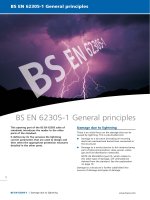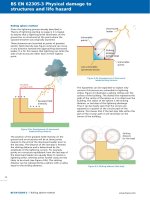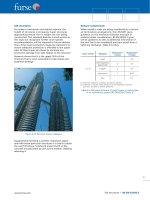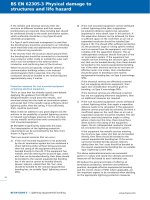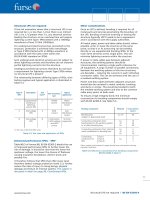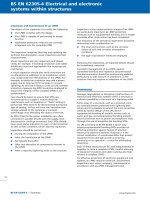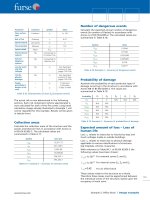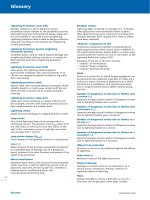Bsi bs en 00728 1997 (bs 2782 11 mtd 1103d 1997)
Bạn đang xem bản rút gọn của tài liệu. Xem và tải ngay bản đầy đủ của tài liệu tại đây (121.48 KB, 12 trang )
BRITISH STANDARD
Plastics piping and ducting
systems Ð
Polyolefin pipes and fittings Ð
Determination of oxidation
induction time
The European Standard EN 728 : 1997 has the status of a British Standard
ICS 23.040.20
NO COPYING WITHOUT BSI PERMISSION EXCEPT AS PERMITTED BY COPYRIGHT LAW
|
|
|
|
|
|
|
|
|
|
|
|
|
|
|
|
|
|
|
|
|
|
|
|
|
|
|
|
|
|
|
|
|
|
|
|
|
|
|
|
|
|
|
|
|
|
|
|
|
|
|
|
|
|
|
|
|
|
|
|
|
|
|
|
|
|
|
|
|
|
|
|
|
|
|
|
|
|
|
|
|
|
|
|
|
|
|
|
|
|
|
|
|
|
|
|
|
|
|
|
|
|
|
|
|
|
|
|
|
|
|
|
|
|
|
|
|
|
|
|
|
|
|
|
|
|
|
|
|
BS EN
728 : 1997
BS 2782 :
Part 11 :
Method 1103D :
1997
BS EN 728 : 1997
Committees responsible for this
British Standard
The preparation of this British Standard was entrusted to Technical Committee
PRI/61, Plastics piping systems and components, upon which the following bodies
were represented:
British Gas plc
British Plastics Federation
British Plumbing Fittings Manufacturers' Association
British Valve and Actuator Manufacturers' Association
Chartered Institution of Water and Environment Management
Department of the Environment (British Board of AgreÁment)
Department of the Environment (Building Research Establishment)
Department of Transport
Electricity Association
Health and Safety Executive
Institute of Building Control
Institute of Materials
Institution of Civil Engineers
Institution of Gas Engineers
National Association of Plumbing, Heating and Mechanical Services Contractors
Pipeline Industries Guild
Plastics Land Drainage Manufacturers' Association
Society of British Gas Industries
Society of British Water Industries
Water Companies Association
Water Services Association of England and Wales
The following bodies were also represented in the drafting of this standard, through
subcommittees and panels:
ERA Technology Ltd.
Engineering Equipment and Materials Users' Association
RAPRA Technology Ltd.
This British Standard, having
been prepared under the
direction of the Sector Board for
Materials and Chemicals, was
published under the authority of
the Standards Board and comes
into effect on
15 July 1997
BSI 1997
Amendments issued since publication
Amd. No.
The following BSI references
relate to the work on this
standard:
Committee reference PRI/61
Draft for comment 92/41379 DC
ISBN 0 580 27392 X
Date
Text affected
BS EN 728 : 1997
Contents
Page
Committees responsible
Inside front cover
National foreword
ii
Foreword
2
Method
3
1
Scope
3
2
Normative references
3
3
Principle
3
4
Materials
3
5
Apparatus
3
6
Test pieces
5
7
Procedure
5
8
Interpretation of results
6
9
Test report
6
Figures
1
Typical calibration curve
4
2
Typical thermogram for polyethylene exhibiting an endothermic reaction
6
BSI 1997
i
BS EN 728 : 1997
National foreword
This British Standard has been prepared by Technical Committee PRI/61 and is the
English language version of EN 728 : 1997 Plastics piping and ducting systems Ð
Polyolefin pipes and fittings Ð Determination of oxidation induction time,
published by the European Committee for Standardization (CEN).
It is incorporated into BS 2782 Methods of testing plastics : Part 11 : Thermoplastics
pipes, fittings and valves, as Method 1103D : 1997, for association with related test
methods for plastics materials and plastics piping components.
This test method has been prepared for reference by other standards under
preparation by CEN for specification of plastics piping and ducting systems and
components. It has been implemented to enable experience of the method to be gained
and for use for other fresh applications.
It is also for use for the revision or amendment of other national standards as
practicable, but it should not be presumed to apply to any existing standard or
specification which contains or makes reference to a different test method until that
standard/specification has been amended or revised to make reference to this method
and adjust any requirements as appropriate.
Cross-references
Publication referred to
Corresponding British Standard
ISO 293
BS 2782 : Part 9 : Method 901A : 1988 Methods of testing
plastics : Part 9 Sampling and test specimen preparation :
Method 901A Compression moulding test specimens of
thermoplastics materials
BS 2782 : Part 7 : Method 720A : 19971) Methods of testing
plastics : Part 7 : Rheological properties : Method 720A
Determination of melt flow rate of thermoplastics
ISO 1133
NOTE 1. For other applications, attention is drawn to BS 2782 : Part 1 : Methods 134A and 134B : 1992
Determination of the oxidation induction time of thermoplastics.
NOTE 2. Attention is drawn to the use in figure 1 of `D' to designate the horizontal axis, for temperature
and in figure 2 of `F' to designate the time axis. This is inconsistent with ISO/TR 10837 : 1991, and with
other test methods prepared by CEN/TC 155 and ISO/TC 138, which generally use `T ' to designate a
temperature axis and `time' or `t' to designate the time axis. `F ' is generally used to designate a force.
Hence the use of `D' and `F' as presented in EN 728 : 1997 should not be copied into other contexts if it
can be avoided.
Warning note. This British Standard, which is identical with EN 728 : 1997, does not
necessarily detail all the precautions necessary to meet the requirements of the Health
and Safety at Work etc. Act 1974. Attention should be paid to any appropriate safety
precautions and the method should be operated only by trained personnel.
Compliance with a British Standard does not of itself confer immunity
from legal obligations.
Summary of pages
This document comprises a front cover, an inside front cover, pages i and ii, the EN
title page, pages 2 to 6, an inside back cover and a back cover.
1)
ii
Under preparation.
BSI 1997
EN 728
EUROPEAN STANDARD
NORME EUROPÊENNE
EUROPẰISCHE NORM
January 1997
ICS 83.140.30
Descriptors: Plastic tubes, thermoplastic resins, polyolefins, pipe fittings, tests, determination, thermal stability, oxidation
English version
Plastics piping and ducting systems Ð Polyolefin pipes and
fittings Ð Determination of oxidation induction time
SysteÁmes de canalisations et de gaines en
plastiques Ð Tubes et raccords en polyoleÂfine Ð
Determination du temps d'induction aÁ l'oxydation
Kunststoff-Rohrleitungs- und Schutzrohrsysteme Ð
Rohre und FormstuÈcke aus Polyolefinen Ð
Bestimmung der Oxidations-Induktionszeit
This European Standard was approved by CEN on 1996-10-27. CEN members are
bound to comply with the CEN/CENELEC Internal Regulations which stipulate the
conditions for giving this European Standard the status of a national standard
without any alteration.
Up-to-date lists and bibliographical references concerning such national standards
may be obtained on application to the Central Secretariat or to any CEN member.
This European Standard exists in three official versions (English, French, German).
A version in any other language made by translation under the responsibility of a
CEN member into its own language and notified to the Central Secretariat has the
same status as the official versions.
CEN members are the national standards bodies of Austria, Belgium, Denmark,
Finland, France, Germany, Greece, Iceland, Ireland, Italy, Luxembourg, Netherlands,
Norway, Portugal, Spain, Sweden, Switzerland and United Kingdom.
CEN
European Committee for Standardization
Comite EuropeÂen de Normalisation
EuropaÈisches Komitee fuÈr Normung
Central Secretariat: rue de Stassart 36, B-1050 Brussels
1997 Copyright reserved to CEN members
Ref. No. EN 728 : 1997 E
Page 2
EN 728 : 1997
Foreword
This European Standard has been prepared by
Technical Committee CEN/TC 155, Plastics piping
systems and ducting systems, the secretariat of which
is held by NNI.
This European Standard shall be given the status of a
national standard, either by publication of an identical
text or by endorsement, at the latest by July 1997, and
conflicting national standards shall be withdrawn at
the latest by July 1997.
This standard is based on ISO/TR 10837 : 1991
Determination of the thermal stability of polyethylene
(PE) for use in gas pipes and fittings, published by
the International Organization for Standardization
(ISO). It is a modification of ISO/TR 10837 : 1991 for
reasons of applicability to other plastics materials
and/or other test conditions and alignment with texts
of other standards on test methods.
The modifications are:
± advice is provided on possible application of the
method to additional thermoplastics;
± test parameters, except those common to all
plastics, are omitted;
± no material-dependent requirements are given;
± editorial changes have been introduced.
The material-dependent parameters and/or
performance requirements are incorporated in the
System Standard(s) concerned.
This standard is one of a series of standards on test
methods which support System Standards for plastics
piping systems and ducting systems.
According to the CEN/CENELEC Internal Regulations,
the national standards organizations of the following
countries are bound to implement this European
Standard: Austria, Belgium, Denmark, Finland, France,
Germany, Greece, Iceland, Ireland, Italy, Luxembourg,
Netherlands, Norway, Portugal, Spain, Sweden,
Switzerland and the United Kingdom.
BSI 1997
Page 3
EN 728 : 1997
1 Scope
This standard specifies a method for measuring the
oxidation induction time in oxygen at a specified
temperature of polyolefin materials for or from pipes
or fittings.
It may be used for assessing the thermal stability of
either raw materials or finished products.
2 Normative references
This standard incorporates by dated or undated
reference, provisions from other publications. These
normative references are cited at the appropriate
places in the text and the publications are listed
hereafter. For dated references, subsequent
amendments to or revisions of any of these
publications apply to this standard only when
incorporated in it by amendment or revision. For
undated references the latest edition of the publication
referred to applies.
ISO 293
Plastics Ð Compression moulding test
pieces of thermoplastic materials
ISO 1133 Plastics Ð Determination of the melt
mass-flow rate (MFR) and the melt
volume-flow rate (MVR) of thermoplastics
3 Principle
It is assumed that a polyolefin material for
manufacture of pipe and/or fittings will incorporate an
additive package which includes one or more
antioxidants or other stabilizers.
The time for which the material, with its additive
package consisting of antioxidant, stabilizers and other
additives present in a test piece, inhibits oxidation is
measured while the test piece is held isothermally at a
specified temperature in a stream of oxygen.
The progress of the oxidation is monitored by
o
measuring the difference in energy flow (DQ) or
temperature (DT) between the test piece pan and
reference pan of a thermal analyser and recording this
difference against time.
The oxidation induction time (OIT) is then derived
from this record as the period during which the
difference in energy flow or temperature remains
constant (see figure 2) between the test piece pan and
reference pan.
This time can be indicative of the effective residual
antioxidant level and reflects the time the test piece
can be exposed in pure oxygen at the test temperature
before the onset of thermal degradation. In normal
atmospheric conditions this time will be longer.
BSI 1997
Depending upon the material and the pipe or fitting
processing, dimensions and service conditions, the
methods of sample and test piece preparation may be
crucial to the consistency of the results and their
significance.
NOTE. It is assumed that the following test parameters are set by
the standard making reference to this standard:
a) the test temperature, T, for the reference pan (see 5.1);
b) the methods of sample and test piece preparation (see 6.2)
and, if applicable, the moulding temperature [see a) of 6.1];
c) the number of test pieces (see 6.3).
It is recommended to choose a temperature which
normally results in induction times of at least 10 min.
4 Materials
4.1 Oxygen
An oxygen supply with a purity of at least 99,5 %.
4.2 Nitrogen
A nitrogen supply with a purity of 99,998 %.
4.3 Reference materials
Two or more temperature reference materials
(calibration standards) of high purity metal having
melting temperatures in the vicinity of the testing
temperature, T [see a) of the note to clause 3].
When T lies between 190 ÊC and 220 ÊC (typical for
testing polyolefins), the calibration metals shall be as
follows:
± indium (melting point 156,6 ÊC) with a purity grade
of at least 99,99 %;
± tin (melting point 231,9 ÊC) with a purity grade of
at least 99,99 %;
where the melting point is derived from the onset in
the DSC diagram (shown as A in figure 1).
4.4 Solvent
A solvent of appropriate composition (see 7.2),
analytical grade.
5 Apparatus
5.1 Differential scanning calorimeter (DSC) or
differential thermal analyser (DTA), capable of:
o
a) recording the difference in energy flow, DQ , or in
temperature, DT, between the test piece pan and the
reference pan against time (see clause 7);
b) exposing a test piece in an open or ventilated
aluminium pan to a flow of 50 ml/min ± 10 % of
nitrogen and 50 ml/min ± 10 % of oxygen in turn so
that each gas changeover is effected in not more
than 1 min. The pan shall have a flat, smooth base
capable of making good contact with the cell base
and with a test piece respectively;
Page 4
EN 728 : 1997
o
DQ
Difference in energy flow
A
Onset temperature (melting point)
C
Melting point
D
Temperature
Figure 1. Typical calibration curve
c) increasing the temperature over the range of
140 ÊC to 250 ÊC at a rate of (1 ± 0,1) ÊC/min when
the cell contains either a temperature calibration
device or a calibration metal (see 4.3 and 7.1);
d) increasing the test piece pan temperature T over
the range from 50 ÊC to the test temperature at a
rate of (20 ± 2) ÊC/min (see 7.2);
e) stabilizing the temperature at (T ± 0,3) ÊC
within 3 min of first reaching (T ± 0,3) ÊC;
f) maintaining the test temperature, T, within ± 0,3 ÊC
for the duration of the test (see 7.2).
NOTE. The design of the instrument oven should ensure that the
test piece compartment is exposed to the required gas flow
[ see b)].
5.2 Temperature measurement device, capable of
continuously monitoring the test piece pan temperature
with a resolution of 0,1 ÊC.
NOTE 1. Test piece pan temperatures are used as the values for
test results.
NOTE 2. This device can be integral with the DSC or DTA
apparatus (see 5.1), but this is not essential. A high impedance
digital voltmeter with a resolution of 1 mV has been found suitable
when connected to a thermocouple and the associated cold
junction, or cold compensator, of the thermal analyser.
5.3 Analytical balance, capable of weighing a test
piece (see clause 6) to a limit of error of 0,1 mg.
5.4 Gas flow control and measuring devices, capable
of providing the required flow rate (see 7.1 and 7.2).
Rotameters are suitable, if they are calibrated against a
positive volume displacement device, e.g. a soap
bubble flowmeter or equivalent.
5.5 Timer, comprising a stopwatch or equivalent.
BSI 1997
Page 5
EN 728 : 1997
6 Test pieces
6.1 Preparation of test piece from raw
materials
Cut one or more test pieces (see 6.3), each having a
mass of (15 ± 2) mg, from a melt flow extrudate
obtained in accordance with ISO 1133, or prepare one
or more test pieces as follows:
a) prepare a compression-moulded plaque in
accordance with ISO 293. Limit heating to 2 min at
the moulding temperature specified by the referring
standard;
b) cut a cylindrical sample with a diameter not less
than half the inside diameter of the test piece pan;
NOTE. It is recommended to use test pieces with a diameter of
approximately 6 mm.
c) cut a test piece from the cylinder to give a test
piece mass of (15 ± 2) mg.
6.2 Preparation of test pieces from a pipe or
fitting
Cut samples from the pipe or fitting in accordance
with the referring standard, so as to obtain one or
more test pieces (see 6.3) each having a mass of
(15 ± 2) mg.
NOTE. For testing of thick-walled polyethylene pipe or fittings the
following method has been found suitable.
Recommended procedure for test piece preparation for pipes and
fittings.
Obtain a cross section of the wall of the pipe and/or fitting by use
of a core drill directed radially through the wall, so that the
diameter of the core preferably is just less than the inner diameter
of the test pan for the test instrument [see note to item b) of 6.1]
and care is taken not to overheat the sample during the cutting
operation. Cut from the core test pieces of the specified mass in
the form of discs as follows.
Select at least the inner-wall surface zone, outer-wall surface zone
and mid-wall zone as the sample points from the core which are
to be tested individually, unless surface effects are of prime
interest. In such cases cut the discs only from the inner and outer
surfaces and test them with surface side uppermost.
6.3 Number of test pieces
The number of test pieces shall be as specified in the
referring standard.
7 Procedure
7.1 Calibration
7.1.1 General
Carry out the procedures given in 7.1.2 and 7.1.3 each
at the frequency necessary to ensure that results
obtained in accordance with 7.2 are obtained under
the specified conditions.
7.1.2 Temperature calibration
7.1.2.1 Ensure that the oven is properly clean, e.g. by
heating up in a nitrogen atmosphere at a temperature
of approximately 500 ÊC to 550 ÊC for at least 10 min
followed after cooling by a cleaning with a cloth, if
necessary.
BSI 1997
Establish an oxygen flow of 50 ml/min ± 10 % through
the apparatus at a temperature of at least 10 ÊC below
the expected melting point of one of the calibration
metals, e.g. indium or tin (see 4.3).
Heat the calibration metal in a sealed aluminium pan
at a rate of 1 ÊC/min until the melting endotherm is
recorded, using an empty sealed aluminium pan as
o
reference. Obtain a plot of DT or DQ against
temperature (e.g. see figure 1). If the apparatus does
not automatically do so, mark the indicated
temperature on a chart at intervals in the region of the
endotherm so that the melting point can be determined
with a precision of ± 0,1 ÊC.
Take the melting point of the metal to be the
temperature given by the intercept of the extended
baseline and the extended tangent to the first slope of
the endotherm, i.e. the onset temperature shown as A
in figure 1.
7.1.2.2 Repeat the procedure given in 7.1.2.1 using a
piece of the other calibration metal.
7.1.2.3 Adjust the apparatus so that the indicated
melting point of indium lies within (156,6 ± 0,3) ÊC and
that of tin lies within (231,9 ± 0,3) ÊC.
NOTE. The described dynamic calibration procedure according
to 7.1.2.3 is expected to correspond to the isothermal calibration
within the experimental error.
7.1.3 Time calibration
For a chart output, use a timer (5.5) to check that the
pen moves along the abscissa at a known rate.
7.4 Measurement of oxidation induction time
Before their use, ensure that the test piece pan(s) and
reference pan are clean, e.g. by cleaning with an
appropriate solvent (see 4.4) such as hexane.
Establish a nitrogen flow of 50 ml/min ± 10 % through
the DSC or DTA. Check that when a switchover to
oxygen is made, the gas flow will continue at that rate.
Revert to a nitrogen flow of 50 ml/min ± 10 %.
Put a test piece into the test piece pan, ensuring as
good initial contact with the pan as possible. If the test
piece includes the inner or outer surface of the source
pipe or fitting (see clause 3), place it in the pan with
that surface uppermost.
Introduce an open or ventilated aluminium pan
containing a test piece and an empty aluminium
reference pan into the instrument. Purge the
instrument oven with nitrogen for 3 min to expel any
oxygen. Set the instrument both to raise the
temperature from an ambient start temperature
of 50 ÊC at a rate of 20 ÊC/min and to run isothermally
at T ÊC until the temperature has stabilized. Start to
record the thermogram as a plot of the energy flow
o
difference (DQ) , or the temperature difference (DT),
against time and record the time as t0, when the
temperature first reaches T ÊC.
Exactly 3 min after t0, switch over to oxygen and
ensure that this point t1 is recorded on the
thermogram. Continue to run the thermogram until the
oxidation exotherm has occurred and has passed its
maximum value (see figure 2).
Page 6
EN 728 : 1997
o
DQ
Difference in energy flow
B
Point of onset of degradation
t
Oxidation induction time
F
Time
Figure 2. Typical thermogram for polyethylene exhibiting an
endothermic reaction
8 Interpretation of results
9 Test report
8.1 OIT calculation
The oxidation induction time, t, of each test piece shall
be the time taken from the switchover to oxygen, t1, to
the time t2 corresponding to the intercept of the
extended baseline and the extended tangent drawn to
the exotherm at the point of maximum slope, shown
as B in figure 2.
The test report shall include the following information:
a) the reference to this standard and to the referring
standard;
b) full identification of the product from which
samples are taken;
c) the position(s) in the pipe or fitting wall cross
section from which the test pieces were derived;
d) the mass of the test piece, in milligrams;
e) the oxidation induction time, t, of each test piece,
and, if applicable, the mean, maximum and
minimum values and a copy of the thermogram(s);
f) the test temperature, T, in degrees Celsius;
g) manufacture, model and type (DSC or DTA) of
instrument used;
h) details of any changes in the test piece
appearance (see 8.2);
i) any factors which may have affected the results,
such as any incidents or any operating details not
specified in this standard;
j) the date of test.
NOTE. In cases when the interpretation using this procedure may
be doubtful, the procedure for obtaining the oxidation induction
time may need to be agreed upon by the parties involved [see i) of
clause 9].
8.2 Behaviour of test piece
After the test, inspect the test piece and record details
of any observed changes.
NOTE. Due to e.g. orientation, the test piece may change in size
or deform in a manner which influences the area/thickness ratio.
This may give erroneous results or high variations in the oxidation
induction times.
BSI 1997
BS EN 728 : 1997
List of references
See national foreword.
BSI 1997
BSI
389 Chiswick High Road
London
W4 4AL
|
|
|
|
|
|
|
|
|
|
|
|
|
|
|
|
|
|
|
|
|
|
|
|
|
|
|
|
|
|
|
|
|
|
|
|
|
|
|
|
|
|
|
|
|
|
|
|
|
|
|
|
|
|
|
|
|
|
|
|
|
|
|
|
|
|
|
|
|
|
|
|
|
|
|
|
|
|
|
|
|
|
|
|
|
|
|
|
|
|
|
|
|
|
|
|
|
|
|
|
|
|
|
|
|
|
|
|
|
|
|
|
|
|
|
|
|
|
|
|
|
|
|
|
|
|
|
BSI Ð British Standards Institution
BSI is the independent national body responsible for preparing British Standards. It
presents the UK view on standards in Europe and at the international level. It is
incorporated by Royal Charter.
Revisions
British Standards are updated by amendment or revision. Users of British Standards
should make sure that they possess the latest amendments or editions.
It is the constant aim of BSI to improve the quality of our products and services. We
would be grateful if anyone finding an inaccuracy or ambiguity while using this
British Standard would inform the Secretary of the technical committee responsible,
the identity of which can be found on the inside front cover. Tel: 020 8996 9000.
Fax: 020 8996 7400.
BSI offers members an individual updating service called PLUS which ensures that
subscribers automatically receive the latest editions of standards.
Buying standards
Orders for all BSI, international and foreign standards publications should be
addressed to Customer Services. Tel: 020 8996 9001. Fax: 020 8996 7001.
In response to orders for international standards, it is BSI policy to supply the BSI
implementation of those that have been published as British Standards, unless
otherwise requested.
Information on standards
BSI provides a wide range of information on national, European and international
standards through its Library and its Technical Help to Exporters Service. Various
BSI electronic information services are also available which give details on all its
products and services. Contact the Information Centre. Tel: 020 8996 7111.
Fax: 020 8996 7048.
Subscribing members of BSI are kept up to date with standards developments and
receive substantial discounts on the purchase price of standards. For details of
these and other benefits contact Membership Administration. Tel: 020 8996 7002.
Fax: 020 8996 7001.
Copyright
Copyright subsists in all BSI publications. BSI also holds the copyright, in the UK, of
the publications of the international standardization bodies. Except as permitted
under the Copyright, Designs and Patents Act 1988 no extract may be reproduced,
stored in a retrieval system or transmitted in any form or by any means ± electronic,
photocopying, recording or otherwise ± without prior written permission from BSI.
This does not preclude the free use, in the course of implementing the standard, of
necessary details such as symbols, and size, type or grade designations. If these
details are to be used for any other purpose than implementation then the prior
written permission of BSI must be obtained.
If permission is granted, the terms may include royalty payments or a licensing
agreement. Details and advice can be obtained from the Copyright Manager.
Tel: 020 8996 7070.

